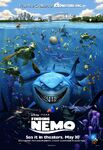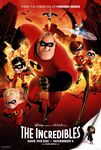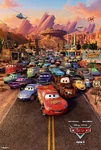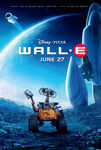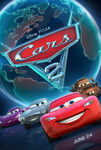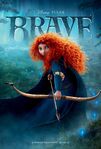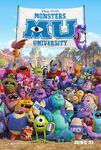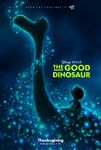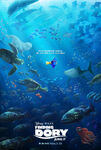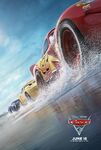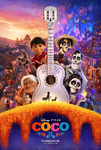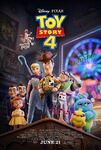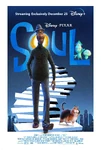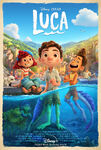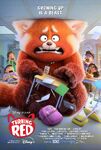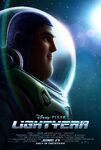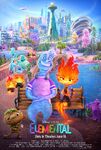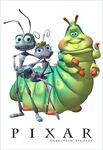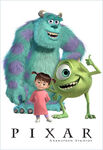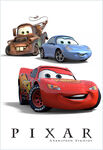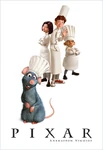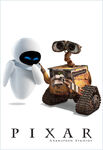Pixar Animation Studios is an American computer animation film studio based in Emeryville, California, and is part of the The Walt Disney Studios. To date, the studio has earned 27 Academy Awards, eight Golden Globes, and three Grammys, along with many other awards and acknowledgements.
It is best known for its revolutionary CGI-animated feature films created with PhotoRealistic RenderMan, its own implementation of the industry-standard RenderMan image-rendering application programming interface used to generate high-quality images. Pixar began in 1979 as the Graphics Group, part of the Computer Division of Lucasfilm before it was acquired by Apple, Inc. founder Steve Jobs in 1986. The Walt Disney Company bought Pixar in 2006 at a valuation of $7.4 billion; the transaction made Jobs the largest shareholder in Disney. It is currently one of the main four Disney branches, the other three being the Disney Animated Canon, the Marvel Cinematic Universe, and Star Wars.
Pixar has produced twenty-eight feature films, beginning with Toy Story in 1995, which is best known for being the first full-length feature film made in CGI animation format ever.
Eighteen of the films has received both critical and financial success, with the notable exceptions being Cars 2, The Good Dinosaur, Onward, and Lightyear. The former, which, although was a financial success, received substantially less praise than Pixar's previous films, while the latter, although met with favorable reviews, was a considered a box office flop (mostly due to the COVID-19 pandemic in 2020). As of December 2013, its feature films have made over $8.5 billion worldwide, with an average worldwide gross of $607 million per film. In addition, a good majority of the films produced by Pixar are among or have been the top 50 highest-grossing animated films of all time, with Finding Nemo (#47), Finding Dory (#32), Toy Story 3 (#26), and Incredibles 2 (#15) all currently in the top 50 highest-grossing films of all time.
Since the award's inauguration in 2001, most of Pixar's films have been nominated for the Academy Award for Best Animated Feature, with eleven winning; Finding Nemo, The Incredibles, Ratatouille, WALL-E, Up, Toy Story 3, Brave, Inside Out, Coco, Toy Story 4, and Soul. Up and Toy Story 3 are two of only three animated films to be nominated for the Academy Award for Best Picture.
On September 6, 2009, executives John Lasseter, Brad Bird, Pete Docter, Andrew Stanton, and Lee Unkrich were presented with the Golden Lion for Lifetime Achievement by the Biennale Venice Film Festival. The award was granted by Lucasfilm founder George Lucas.
In Ralph Breaks the Internet, Anna referred to Pixar as "the other studio".
It is a member of Disney's big three animation studios, the other two being Walt Disney Animation Studios and 20th Century Animation.
History of Pixar
Early history
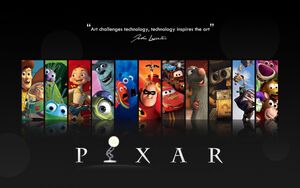
The eleven movies made by Pixar up to 2010.
Pixar was founded as The Graphics Group, one third of the Computer Division of Lucasfilm which was launched in 1979 with the hiring of Dr. Ed Catmull from the New York Institute of Technology (NYIT), where he was in charge of the Computer Graphics Lab (CGL). At NYIT, the researchers pioneered many of the CG foundation techniques—in particular the invention of the "alpha channel" (by Catmull and Alvy Ray Smith); years later, the CGL produced an experimental film called The Works.
After moving to Lucasfilm, the team worked on creating the precursor to RenderMan, called REYES (for "renders everything you ever saw") and developed a number of critical technologies for CG—including "particle effects" and various animation tools.
The team began working on film sequences with Industrial Light & Magic on special effects in 1982. After years of research, and key milestones in films such as the Genesis Effect in Star Trek II: The Wrath of Khan and the Stained Glass Knight in Young Sherlock Holmes, the group, which numbered about 45 individuals at the time, was purchased in February 1986 by Steve Jobs shortly after he left Apple Computer. Jobs paid $5 million to George Lucas and put $5 million as capital into the company.
A factor contributing to Lucas' sale was an increase in cash flow problems following his 1983 divorce, which coincided with the sudden drop-off in revenues from Star Wars licenses following the release of Return of the Jedi. Pixar spun off from Lucasfilm as a result. The newly independent company was headed by Jobs, who served as Chairman and Chief Executive Officer of Pixar. Dr. Edwin Catmull served as Chief Technology Officer and Dr. Alvy Ray Smith as Executive Vice President and Director. In 2001, Edwin Catmull was named President of Pixar.
Initially, Pixar was a high-end computer hardware company whose core product was the Pixar Image Computer, a system primarily sold to government agencies and the medical community. One of the buyers of Pixar Image Computers was Disney Studios, which was using the device as part of their secretive CAPS project, using the machine and custom software to migrate the laborious ink and paint part of the 2-D animation process to a more automated and thus efficient method. The Image Computer never sold well. In a bid to drive sales of the system, Pixar employee John Lasseter—who had long been creating short demonstration animations, such as Luxo Jr., to show off the device's capabilities—premiered his creations at SIGGRAPH, the computer graphics industry's largest convention, to great fanfare.
As poor sales of Pixar's computers threatened to put the company out of business, Lasseter's animation department began producing computer-animated commercials for outside companies. Early successes included campaigns for Tropicana, Listerine, Life Savers, and Terminator 2: Judgment Day. In April 1990, Jobs sold Pixar's hardware division, including all proprietary hardware technology and imaging software, to Vicom Systems, and transferred 18 of Pixar's approximate 100 employees.
The same year, Pixar moved from San Rafael to Richmond, California. During this period, Pixar continued its relationship with Walt Disney Feature Animation, a studio whose corporate parent would ultimately become its most important partner. In 1991, after a tough start of the year when about 30 employees in the company's computer department had to go (including the company's president, Chuck Kolstad), which reduced the total number of employees to just 42, Pixar made a $26 million deal with Disney to produce three 3D computer-animated feature films, the first of which was Toy Story. At that point, the software programmers, who were doing RenderMan and CAPS, and Lasseter's animation department, who made television commercials and a few shorts for Sesame Street, was all that was left of Pixar.
Despite the total income of these products, the company was still losing money, and Jobs often considered selling it. Even as late as 1994, Jobs contemplated selling Pixar to other companies, among them Microsoft. Only after confirming that Disney would distribute Toy Story for the 1995 holiday season did he decide to give it another chance. The film went on to gross more than $350 million worldwide. Later that year, Pixar held its initial public offering on November 29, 1995, and the company's stock was priced at US$22 per share.
Disney

Pixar and Disney had disagreements after the production of Toy Story 2. Originally intended as a straight-to-video release (and thus could've been part of Pixar's three-picture deal), the film was eventually upgraded to a theatrical release during production. Pixar demanded that the film then is counted toward the three-picture agreement, but Disney refused. Pixar's first five feature films have collectively grossed more than $2.5 billion, equivalent to the highest per-film average gross in the industry.
Though profitable for both, Pixar later complained that the arrangement was not equitable. Pixar was responsible for creation and production, while Disney handled marketing and distribution. Profits and production costs were split 50-50, but Disney exclusively owned all story and sequel rights and also collected a distribution fee. The lack of story and sequel rights was perhaps the most onerous aspect to Pixar and set the stage for a contentious relationship.
The two companies attempted to reach a new agreement in early 2004. The new deal would be only for distribution, as Pixar intended to control production and own the resulting film properties themselves. The company also wanted to finance their films on their own and collect 100 percent of the profits, paying Disney only the 10 to 15 percent distribution fee. More importantly, as part of any distribution agreement with Disney, Pixar demanded control over films already in production under their old agreement, including The Incredibles and Cars. Disney considered these conditions unacceptable, but Pixar would not concede.
Disagreements between Steve Jobs and then Disney Chairman and CEO Michael Eisner made the negotiations more difficult than they otherwise might have been. They broke down completely in mid-2004, with Jobs declaring that Pixar was actively seeking partners other than Disney. Pixar did not enter negotiations with other distributors. After a lengthy hiatus, negotiations between the two companies resumed following the departure of Eisner from Disney in September 2005.
In preparation for potential fallout between Pixar and Disney, Jobs announced in late 2004 that Pixar would no longer release movies at the Disney-dictated November time frame, but during the more lucrative early summer months. This would also allow Pixar to release DVDs for their major releases during the Christmas shopping season. An added benefit of delaying Cars was to extend the time frame remaining on the Pixar-Disney contract to see how things would play out between the two companies.
Pending the Disney acquisition of Pixar, the two companies created a distribution deal for the intended 2007 release of Ratatouille, in case the acquisition fell through, to ensure that this one film would still be released through Disney's distribution channels. (In contrast to the earlier Disney/Pixar deal, Ratatouille was to remain a Pixar property and Disney would have received only a distribution fee.) The completion of Disney's Pixar acquisition, however, nullified this distribution arrangement. Unlike the earlier Pixar/Disney deal used for the earlier films, this one has the following caveats:
- Pixar is responsible for 100% of the production costs.
- Pixar owns the film and the rights to the characters.
- Disney is paid only a straight distribution fee.
Acquisition by Disney
Disney announced on January 24, 2006 that it had agreed to buy Pixar for approximately $7.4 billion in an all-stock deal. Following Pixar shareholder approval, the acquisition was completed May 5, 2006. The transaction catapulted Steve Jobs, who was the majority shareholder of Pixar with 50.1%, to Disney's largest individual shareholder with 7% and a new seat on its board of directors. Jobs' new Disney holdings exceeded holdings belonging to former CEO Michael Eisner, the previous top shareholder, who still held 1.7%; and Disney Director Emeritus Roy E. Disney, who held almost 1% of the corporation's shares. Pixar's shareholders received 2.3 shares of Disney common stock for each share of Pixar common stock redeemed.
As part of the deal, John Lasseter, by then Executive Vice President, became Chief Creative Officer (reporting to President and CEO Robert Iger and consulting with Disney Director Roy Disney) of both Pixar and the Walt Disney Animation Studios, as well as the Principal Creative Adviser at Walt Disney Imagineering, which designs and builds the company's theme parks. Catmull retained his position as President of Pixar, while also becoming President of Walt Disney Animation Studios, reporting to Bob Iger and Dick Cook, chairman of Walt Disney Studio Entertainment. Steve Jobs' position as Pixar's Chairman and Chief Executive Officer was also removed, and instead, he took a place on the Disney board of directors.
Lasseter and Catmull's oversight of both the Disney and Pixar studios did not mean that the two studios were emerging, however. In fact, additional conditions were laid out as part of the deal to ensure that Pixar remained a separate entity, a concern that analysts had expressed about the Disney deal. Some of those conditions were that Pixar HR policies would remain intact, including the lack of employment contracts. Also, the Pixar name was guaranteed to continue, and the studio would remain in its current Emeryville, California location with the "Pixar" sign. Finally, branding of films made post-merger would be "Disney•Pixar" (beginning with Cars).
Jim Morris, producer of WALL-E, has been named general manager of Pixar. In this new position, Morris is in charge of the day-to-day running of the studio facilities and products. There were additional conditions laid out as part of the deal to ensure that Pixar remains a separate entity, a concern that many analysts had about the Disney deal [1]:
- If Pixar should pull out of the deal, they must pay Disney a penalty of US $210 million.
- The Disney board would include Steve Jobs.
- John Lasseter has the authority to approve films for both Disney and Pixar studios, with Disney CEO Robert Iger carrying final approving authority.
- The deal requires that Pixar's primary directors and creative executives must also join the combined company. This includes Andrew Stanton, Pete Docter, Brad Bird, Bob Peterson, Brenda Chapman, Lee Unkrich, and Gary Rydstrom.
- There would be a steering committee that will oversee animation for both Disney and Pixar studios, with a mission to maintain and spread the Pixar culture. This committee will consist of Catmull, Lasseter, Jobs, Iger, Cook, and Tom Staggs. They would meet at Pixar headquarters at least once every two months.
- Pixar's HR policies would remain intact, including the lack of employment contracts.
- Ensures the Pixar name would continue, and that the studio would remain in its current Emeryville, California location with the "Pixar" sign.
- Branding of films made post-merger would "Disney Pixar".
Expansion
On April 20, 2010, Pixar Animation Studios opened a new studio in the downtown area of Vancouver, British Columbia, Canada. The roughly 2,000 square meters studio is primarily responsible for producing shorts and TV specials based on characters from Pixar's feature films. The studio's first production was the Cars Toons episode "Air Mater".
Traditions
While some of Pixar's first animators were former cel animators, including John Lasseter, they also came from stop motion animation and/or computer animation or were fresh college graduates. A large number of animators that make up the animation department at Pixar were hired around the time Pixar released A Bug's Life and Toy Story 2. Although Toy Story was a successful film, it was Pixar's only feature film at the time. The majority of the animation industry was and is still located in Los Angeles, California, while Pixar is located 350 miles north in the San Francisco Bay Area. Also, traditional 2-D animation was still the dominant medium for feature animated films.
With the death of Los Angeles–based animators - including Joe Ranft - willing to move their families so far north, give up traditional animation, and try computer animation, Pixar's new-hires at this time either came directly from the college or had worked outside feature animation. For those who had traditional animation skills, the Pixar animation software (Marionette) is designed so that traditional animators would require a minimum amount of training before becoming productive.
In an interview with PBS talk show host Tavis Smiley, Lasseter said that Pixar films follow the same theme of self-improvement as the company itself has: with the help of friends or family, a character ventures out into the real world and learns to appreciate his friends and family. At the core, Lasseter said, "it's gotta be about the growth of the main character, and how he changes."
Pixar has been criticized for its lack of female protagonists. Brave, Pixar's 13th cinema release, is the studio's first with a female lead (voiced by Kelly Macdonald). By the MPAA, most of the films are rated G, while 15 of them are rated PG (The Incredibles, Up, Brave, Inside Out, The Good Dinosaur, Finding Dory, Coco, Incredibles 2, Onward, Soul, Luca, Turning Red, Lightyear, Elemental, and Inside Out 2). However, the G rated Cars 2 contained violence and rude humor, making it be considered to be too dark for its rating. Except for Cars 2, their films have had positive reviews, with 10 films (the only exceptions being Cars, Brave, Monsters University, The Good Dinosaur, Cars 3, and Onward) being above 90% on Rotten Tomatoes.
All Pixar films are box office successes except for The Good Dinosaur, which worldwide made $317.5 million on a $200 million budget, and Onward made $109.4 million in worldwide on a $200 million budget.
Sequels, prequels, and spin-offs
Toy Story 2 was commissioned by Disney as a direct-to-video, 60-minute film. Feeling the material was not very good, John Lasseter convinced the Pixar team to start from scratch and make that their third full-length feature film. Toy Story 3 was the second big-screen sequel and was released on June 18, 2010. On June 27, 2011, Tom Hanks implied that a fourth Toy Story movie was in the works, and in 2015, Toy Story 4 was announced for a June 16, 2017 release date. On February 8, 2023 during a call, Disney CEO Bob Iger announced that Toy Story 5 is in development.
Pixar states that they believe that sequels should only be made if they can come up with a story as good as the original. Following the release of Toy Story 2, Pixar and Disney had a gentlemen's agreement that Disney would not make any sequels without Pixar's involvement, despite their right to do so. In 2004, after Pixar announced they were unable to agree on a new deal, Disney announced that they would go ahead with sequels to Pixar's films with or without Pixar. Toy Story 3 was put into pre-production at the new CGI division of Walt Disney Feature Animation, Circle 7 Animation.
When Lasseter was placed in charge of all Disney and Pixar animation following the merger, he shut down Circle 7 and immediately put all sequels on hold; Disney stated that Toy Story 3 had been canceled. However, in May 2006, it was announced that Toy Story 3 was back in pre-production, under Pixar's control when a new plot had been conceived.
In 2020, Pete Docter revealed a spin-off to Toy Story titled Lightyear.
Cars 2, the studio's third theatrical sequel, was released on June 24, 2011.
Lasseter further fueled speculation on future sequels when he stated, "If we have a great story, we'll do a sequel". Cars 2, Pixar's first sequel not based on Toy Story, was officially announced on April 8, 2008.
Monsters University, the prequel to Monsters, Inc. and Pixar's first prequel, was announced on April 22, 2010, for release on November 2, 2012. However, on April 5, 2011, it was announced that the film's release date had been pushed back to June 21, 2013, due to the success of Pixar films that are released in the summer, according to Disney distribution executive Chuck Viane.
In 2014, Brad Bird claimed to have begun pre-production on a sequel to The Incredibles, with it being eventually revealed as Incredibles 2.
After Toy Story 4, Pixar chief Pete Docter said that the studio would take a break from sequels and focus on original projects. However, in a later interview, Docter said the studio would have to return to making sequels at some point as they are more "financially secure and help keep the studio running." On September 9, 2022, during the D23 Expo, Docter and Amy Poehler (voice of Joy) confirmed that Inside Out 2 was in the works, and was released on June 14, 2024. In August 2024, during the D23 Expo, Docter announced that Incredibles 3 is in development, with Brad Bird returning as the director.
Expansion to television
Toy Story was the first Pixar film to be extended into television, with the Buzz Lightyear of Star Command film and TV series, plus a series of shorts known as Toy Story Toons, which not only run between regular Disney Channel shows, but all of them were also shown theatrically in front of certain movies.
Cars was expanded to television via Cars Toons, two different lineups of shorts running between regular Disney Channel shows. The first batch was known as Mater's Tall Tales (3 to 5 minutes), where Mater (voiced by comedian Larry the Cable Guy) tells Lightning McQueen (voiced by Keith Ferguson) a story about something he did in the past that is eventually revealed to be real. The second batch was known as Tales from Radiator Springs (around 1 minute), where different characters get into a quick scenario. Only 1 of these shorts feature Owen Wilson reprising McQueen. The series has also had its own TV series released on Disney+.
Monsters, Inc. extended into television through Monsters at Work, which takes place before the epilogue in the original movie and sees Tylor Tuskmon trying to get accepted to be part of the Laugh Floor while helping his friends and co-workers as a mechanic in the Monsters, Inc. Facilities Team.
Animation and live-action
All Pixar films to date have been computer-animated features (WALL-E has so far been the only Pixar film not to be completely animated, featuring a small live-action element). 1906, a planned live-action film by Brad Bird about the 1906 San Francisco earthquake, was once reported to be in development. Bird has stated that he was "interested in moving into the live-action realm with some projects" while "staying at Pixar because it's a very comfortable environment for me to work in." However, while nothing came of 1906, Pixar did develop a live-action reality show for Disney+, known as Pixar: In Real Life.
Additionally, in the Jungle Book (2016), the producers is wish to thanks to Pixar, along with Walt Disney Animation Studios and other employees.
Product pipeline
In 2008, Pixar announced Newt, a story about the last two blue-footed newts in existence destined to mate to save their species from extinction, scheduled for release in June 2012. This project was to be followed by the fantasy film The Bear and the Bow.
In April 2010, Disney/Pixar announced that, instead, The Bear and the Bow would be released first, under the new name Brave, followed by a sequel (technically a prequel) to their 2001 feature Monsters, Inc. later that year. Newt was also removed from the official Disney A to Z Encyclopedia supplement by chief archivist Dave Smith, who confirmed that the film had been canceled. In May 2011, Pixar CCO John Lasseter implied that Newt had been shelved due to it having a similar plot-line to Blue Sky Studios' film Rio (which is now under the Disney umbrella). Edwin Catmull revealed in May 2014, before being cancelled, the project was turned over to Pete Docter, who said that while he would direct it, he had "another idea altogether" that he, and eventually the rest of Pixar, thought was better; that idea would become Inside Out, released in 2015.
In April 2012, Pixar announced their intention to create a film centered on the Mexican holiday Día de los Muertos and to be directed by Lee Unkrich, under the new name Coco.
Executive leadership
Up until his death in late 2011, Jobs continued in his role as chairman and was also the company's CEO. Catmull remains president. Lasseter —a two-time Academy Award-winning director and animator— oversaw all the company's projects as Executive Vice President of the Creative Department until 2018, when he left Pixar and Pete Docter became the new Executive Vice President of the Creative Department. Other notable members of the executive team are Sarah McArthur (Executive Vice President of Production), Simon Bax (Executive Vice President and CFO), and Lois Scali (Executive Vice President and General Counsel).
Exhibitions
Since December 2005, Pixar has held exhibitions celebrating the art and artists of Pixar, over their first twenty years in animation.
Pixar: 20 Years of Animation
Pixar held one such exhibition, from April to June 2010, at Science Centre Singapore, in Jurong East, Singapore. It was their first time holding an exhibition in Singapore.
The exhibition highlights consist of work-in-progress sketches from various Pixar productions, clay sculptures of their characters, and an auto-stereoscopic short showcasing a 3D version of the exhibition pieces which is projected through 4 projectors. Another highlight is the Zoetrope, where visitors of the exhibition are shown figurines of Toy Story characters "animated" in real-life through the zoetrope.
The logo is the same as the 1995 version, except as the screen darkens to reveal only Luxo's light, "20 Years of Animation" appears on-screen, with Luxo's light as the "0".
Pixar: 25 Years of Animation
Pixar celebrated 25 years of animation in 2011 with the release of its twelfth feature film Cars 2. Pixar had celebrated its 20th anniversary with the first Cars. The Pixar: 25 Years of Animation exhibition was held at the Oakland Museum of California from July 2010 until January 2011. The exhibition tour debuts in Hong Kong and was held at the Hong Kong Heritage Museum in Sha Tin, between March 27 and July 11, 2011.
Pixar: 25 Years of Animation includes all the artwork from Pixar: 20 Years of Animation, plus art from Ratatouille, WALL-E, Up, and Toy Story 3.
The Science Behind Pixar
- Main article: The Science Behind Pixar
The Science Behind Pixar is a traveling exhibition, developed by the Museum of Science in Boston, Massachusetts in collaboration with Pixar, that teaches about the production pipeline at Pixar in the form of the filmmaking process. The exhibition's tour started at the Museum of Science in mid-2015 and is expected to last ten years with limited tour availability beginning in 2021.
Films
Upcoming films
Short films ("Shorts")
- Main article: List of Pixar shorts
- The Adventures of André and Wally B. (1984, Lucasfilm, prior to the creation of Pixar)
- Luxo, Jr. (1986, became the source of today's Pixar logo and is an Academy Award nominee and released with Toy Story 2 in 1999 complete with an introduction about the titular lamp becoming a mascot)
- Red's Dream (1987)
- Tin Toy (1988, Academy Awards winner 1988 released on various home video releases of Toy Story since 2000)
- Knick Knack (1989 and released with Finding Nemo in 2003, albeit remastered, and is the final pre-1995 short to be released with a feature film)
- Geri's Game (1997, Academy Awards winner 1997 and released with A Bug's Life in 1998)
- For the Birds (2000, Academy Awards winner 2001 and released with Monsters, Inc. in 2001)
- Mike's New Car (2002, based on characters from Monsters, Inc. and is an Academy Award nominee)
- Boundin' (2003, Academy Awards nominee 2003 and released with The Incredibles in 2004)
- Jack-Jack Attack (2005, based on characters and situations from The Incredibles)
- One Man Band (2005, Academy Awards nominee 2005 and released with Cars in 2006)
- Mater and the Ghostlight (2006, based on characters from Cars)
- Lifted (2006, Academy Awards nominee 2006 and released with Ratatouille in 2007)
- Your Friend the Rat (2007, based on characters from Ratatouille)
- Presto (2008, Academy Awards nominee 2008 and released with WALL-E)
- BURN-E (2008, based on characters and situations from WALL-E)
- Partly Cloudy (2009 and released with Up)
- Dug's Special Mission (2009, based on characters and situations from Up)
- George & A.J. (also 2009, based on characters and situations from Up)
- Day & Night (2010, Academy Awards nominee 2010 and released with Toy Story 3)
- La Luna (2011, Academy Awards nominee 2011 and released with Brave in 2012)
- The Blue Umbrella (2013 and released with Monsters University)
- Party Central (2013, based on characters from Monsters University and released with Muppets Most Wanted in 2014)
- Lava (2014; was released with Inside Out in 2015)
- Riley's First Date? (2015, based on the characters from Inside Out)
- Sanjay's Super Team (2015, Academy Awards nominee 2015 and released with The Good Dinosaur)
- Piper (2016, Academy Awards winner 2016 and released with Finding Dory)
- Marine Life Interviews (2016, based on characters from Finding Dory)
- Lou (2017, Academy Awards nominee 2017 and released with Cars 3)
- Miss Fritter's Racing Skoool (2017, based on characters from Cars 3)
- Bao (2018 Academy Awards winner 2018 and released with Incredibles 2. Future short films would be released exclusively for Disney+ via SparkShorts)
- Auntie Edna (2018, based on characters and situations from Incredibles 2)
- Purl (2019 the first installment of the Sparkshorts series)
- Smash and Grab (2019)
- Kitbull (2019 Academy Award nominee 2019)
- Float (2019)
- Wind (2019)
- Loop (2020)
- Lamp Life (2019, based on characters from Toy Story 4)
- Out (2020)
- Burrow (2020 Academy Awards nominee 2020)
- 22 vs. Earth (2021, based on the characters from Soul)
- Twenty Something (2021)
- Nona (2021)
- Ciao Alberto (2021, based on the characters from Luca)
- Carl's Date (2023, based on the characters from Up and released with Elemental)
- Self (2024)
Feature film traditions
The Pixar Format
All Pixar features have a common theme. The setting of the film is always a world in which people/creatures/objects that are not commonly thought to have normal everyday lives live in societies resembling modern American society. For example:
- Toy Story, Toy Story 2, Toy Story 3, Toy Story 4, and Toy Story 5 — Toys come to life and have adventures when their owners are away.
- A Bug's Life — Insects live in harmony and have their own hierarchy and tiny little cities.
- Monsters, Inc. and Monsters University — Horrifying monsters live everyday lives in their own community. Scaring kids is just their day job.
- Finding Nemo and Finding Dory — The ocean, like Earth's land mass, has its own cities, schools, and communities ruled by fish.
- The Incredibles, Incredibles 2, and Incredibles 3 — Superheroes live among us and take ordinary jobs and have ordinary problems, such as a greedy boss or a troublemaking son.
- Cars, Cars 2, and Cars 3 — Vehicles live by themselves without humans.
- Ratatouille — A rat visits Paris and wants to cook.
- WALL-E — A little robot finds adventure in space.
- Up — An old man's house gets lifted by balloons and he finds adventure.
- Brave — In a kingdom, a rebellious princess wants to live as freely as she desires.
- Inside Out and Inside Out 2 — Taking place inside a girl's mind, five emotions have conflict helping her adjust to a new life in a new place.
- The Good Dinosaur — A young dinosaur tries to find his way home with the help of a strange caveboy.
- Coco — A living boy ends up in the Land of the Dead, a place where people live as skeletons after they die.
- Onward — Takes place in a world consisting of fantasy creatures that depended on modern appliances and abandons magic.
- Soul — A jazz performer's soul wants to try and get back into his original body after an accident.
- Luca — A young sea monster explores the surface above the ocean and shape shifts into a human.
- Turning Red — A confident thirteen-year-old "poofs" into a giant red panda whenever she gets too excited or stressed due to her ancestor's mystical connection with red pandas.
- Lightyear — Buzz Lightyear, a young astronaut, tries to find a way back home through space and time, while also confronting a threat to the universe's safety after being marooned on a hostile planet.
- Elemental — Personifications of fire, water, earth, and air live together in a world separated of the Earth.
- Elio — An 11-year-old boy finds himself transported across the galaxy and is mistaken for the intergalactic ambassador of our planet Earth.
- Hoppers — A young girl hops her mind into a robot beaver and navigates the animal world.
John Ratzenberger
John Ratzenberger, most widely known as the postman Cliff Clavin from the television sitcom Cheers, is always a character voice, referred to by the studio as their "good luck charm". The following is a list of his roles:
- Toy Story, Toy Story 2, Toy Story 3, and Toy Story 4 — Hamm (a piggy bank)
- A Bug's Life — P.T. Flea (the manager of a traveling insect circus/a fly in his soup at the Bug Bar; his favorite role)
- Monsters, Inc. and Monsters University — The Abominable Snowman (a yeti)
- Finding Nemo — the ringleader of a school of moonfish
- The Incredibles and Incredibles 2 — The Underminer (a supervillain)
- Cars, Cars 2, and Cars 3 — Mack (a Mack truck). This includes in-jokes parodying his use as a voice and characters in parodies of Toy Story ("Toy Car Story"), Monsters, Inc. ("Monster Trucks, Inc."), and A Bug's Life (using Volkswagen Beetles) and how the voice is the same.
- Ratatouille — Mustafa (the head waiter)
- WALL•E — John (one of the human passengers aboard the Axiom
- Up — Tom the construction foreman
- Brave — Gordon the Guard
- Inside Out and Inside Out 2 — Fritz (one of the mind workers who built the new expanded console at the Emotions' Headquarters in Riley's mind)
- The Good Dinosaur — Earl
- Finding Dory — Bill (a crab)
- Coco — Juan Ortodoncia (a skeleton)
- Onward — Fennwick (a construction worker)
Outside of Pixar, he voiced a character in the English dub of Spirited Away, overseen by John Lasseter. He has become such a stable part of the company that he plays on its softball team.
He also voiced Rootie in the 2022 Skydance movie Luck. The movie is a lot like a Pixar movie, Lasseter was even one of the producers.
Joe Ranft
Like John Ratzenberger, Pixar animator Joe Ranft had made the voice of characters in all the Pixar films until Cars, which was completed after his untimely passing and noted in the credits of the film. The following is a list of his roles in the first seven Pixar movies:
- Toy Story — Lenny the Binoculars
- A Bug's Life — Heimlich the Caterpillar/additional voices including the fly who demanded a refund
- Toy Story 2 — Wheezy the Penguin/Heimlich the Caterpillar during the outtakes.
- Monsters, Inc. - Pete "Claws" Ward/additional voices
- Finding Nemo — Jacques the Shrimp
- The Incredibles — additional voices
- Cars — Red the fire truck and Peterbilt (released posthumously)
Following his death, many of his characters were taken on by his younger brother, Jerome, who is also a Pixar animator.
Bonnie Hunt
Joe Ranft holds the second-long Pixar vocal performance tenure, but the person who has appeared in the second most Pixar films is Bonnie Hunt. The following is her list of roles in Pixar movies:
- A Bug's Life – Rosie (a Black Widow spider)
- Monsters, Inc. – Ms. Flint (a monster desk worker)
- Cars, Cars 2, and Cars 3 – Sally Carrera (a Porsche 916)
- Toy Story 3 and Toy Story 4 – Dolly (a stuffed doll)
- Monsters University – Karen Graves (a monster school teacher)
- Onward – Mermaid
References to upcoming films
Some of Pixar's notorious Easter eggs are references to Pixar films that were still in production at the time of release, making them references to upcoming Pixar films. Although it hasn't been as consistent as some of their other Easter eggs, in recent years it has become a tradition for Pixar to put in each of their films a cameo of or an allusion to a character from their following film. The first Toy Story is the only film not to have a reference to an upcoming film.
Examples
- A Bug's Life - Woody makes a cameo in one of the alternate outtakes during the end credits, an allusion to Toy Story 2.
- Toy Story 2:
- Monsters, Inc.:
- Finding Nemo:
- A boy in the dentist's waiting room is reading a Mr. Incredible comic book, a reference to The Incredibles.
- A non-anthropomorphic version of Luigi from Cars drives by when the tank gang finally escapes the dentist's office.
- The Incredibles - A non-anthropomorphic version of Red from Cars is seen during the bank robbery and another non-anthropomorphic version of Doc Hudson is parked in a street of Metroville during the final battle.
- Cars - In the Cozy Cone Motel, there is a picture of the Eiffel Tower, an allusion to Ratatouille.
- Ratatouille:
- Your Friend the Rat - WALL•E from the film of the same name is the driver of the vehicle on Mars. This reference is unique as this was in a short, not a movie.
- WALL•E - Carl Fredricksen's walking cane from Up can be seen upside down (with the tennis balls attached to the feet) on two occasions. Firstly, when WALL•E is about to pull across the magnifying screen the walker is sitting behind the iPod. Secondly, when WALL•E falls down from the ceiling of his truck (after being knocked there by EVE), he collides with the walker.
- Up - Lots-o'-Huggin' Bear from Toy Story 3 is placed next to the bed of a little girl who watches the balloons and Carl's house rise outside her bedroom window.
- Toy Story 3:
- Finn McMissile from Cars 2 is featured on a poster in Andy's room.
- Also in Andy's room is a "Newt Xing" sign, an allusion to Newt. Even though Newt was canceled, it had been set to be released in 2012 (two years after Toy Story 3), and as such, this was technically a reference to an upcoming film.
- Cars 2 - A car-ified version of the DunBroch family tapestry from Brave appears in the Ye Left Turn Inn in London.
- Brave:
- Monsters University:
- Art gives Mike Wazowski and James P. Sullivan a dream journal with a unicorn and a rainbow, an allusion to Rainbow Unicorn from Inside Out.
- Toy versions of dinosaur characters from The Good Dinosaur appear in the Scare simulators used for the final event of the Scare Games.
- Toy Story of Terror - The paintings hung in the motel room depict dinosaurs under a tree, another allusion to The Good Dinosaur.
- Toy Story That Time Forgot - According to director Steve Purcell, the three posters in Mason's gaming room were allusions to three of Pixar's then-upcoming films: Inside Out, Cars 3 and Coco.
- Inside Out - Giant statues of Forrest Woodbush and Arlo from The Good Dinosaur are seen in Riley's memories of the road trip to San Francisco.
- The Good Dinosaur - Hank from Finding Dory appears at the bottom of the water when Arlo learns to swim.
- Finding Dory - The driver of the truck heading for Cleveland at the end of the film has a Band-Aid with an image of Lightning McQueen on his right hand, a reference to Cars 3.
- Cars 3:
- The image Cruz Ramirez displays to motivate a homesick trainee is the Santa Cecilia Grave from Coco.
- The Shiny Guitar from Coco is hung on the wall behind the band playing at the Cotter Pin Bar at Thomasville.
- Coco - As Miguel and Héctor are on their way to the Land of the Dead talent show, an Incredibles poster is briefly seen, an allusion to Incredibles 2.
- Incredibles 2 - A Duke Caboom action figure from Toy Story 4 is seen in Jack-Jack's playpen.
- Toy Story 4 - The pegasus on the side of Barley Lightfoot's van is seen on the bouncy castle at the carnival, an allusion to Onward.
- Onward - When Colt Bronco knocks over Barley Lightfoot's Quests of Yore board game, in the left side on a bookshelf, you can see a music album of Dorothea Williams, a human jazz performer in the Pixar film Soul.
- Soul:
- Just before Joe Gardner falls down a manhole at the beginning, he narrowly avoids a biker driving a Vespa, Luca Paguro and Alberto Scorfano's dream vehicle in Luca.
- A poster on the left of a travel agency's window reads "Visit Portorosso", a major location in Luca.
- Luca - There is an Italian logo that says "4 (Star) Villaggi", a reference to the boy band 4 Town in Turning Red.
- Monsters at Work - In episode 3, a toy red panda is seen, an allusion to Turning Red.
- Turning Red - Miriam's skateboard has a sticker of Buzz Lightyear's Star Command logo and Sox on it as a reference to Lightyear.
- Lightyear - Water bottles in the snack machine are labeled "Wade Water", in reference to Wade Ripple; a main character from Elemental.
- Elemental:
- One of the snack brands sold at The Fireplace is "SparkJoy", which in addition to being a pastiche both of "Wrigley's Spearmint" as "Almond Joy", is also a reference to the Inside Out character, Joy, who would return in Inside Out 2.
- One of the signs in Firetown has letters in the Firish language with the colors of core Emotions, including orange, the color of Anxiety, a character who would debut in Inside Out 2.
- Harold's painting seen during the Ripples' dinner includes the colors of emotions (red, yellow, green, blue, and purple) and adds orange, cyan, indigo, and pink, in reference to Inside Out 2.
- A poster in the background for a space club, a reference to Elio.
- Ooooo, Elio's alien companion can be seen in the crowd at the Cyclone Stadium cheering at Lutz.
- Inside Out 2 - One of Riley's memories shows the title character from Elio.
- Elio — TBA
- Hoppers — TBA
- Toy Story 5 — TBA
- Incredibles 3 — TBA
A113
Similar to George Lucas' 1138, the letter-number sequence A113 is an animation in-joke that appears in all Pixar films to date, except Monsters, Inc. It is a reference to one of the room numbers at CalArts (where several of the employees are alumni).
Examples
- Toy Story: As Ms. Davis' license plate number.
- A Bug's Life: As a code on a cereal box as Flik enters the bug city. Also, on the Casey Jr. Cookies wagon as "Vitamin A113".
- Toy Story 2: One of the announcements at the airport calls for a "LassetAir Flight A113", also referencing John Lasseter. Appears again on Ms. Davis' license plate.
- Finding Nemo: As the model code for the diver's underwater camera.
- The Incredibles: A room number in Syndrome's lair, as Level A1, Room #13, the conference room where Mr. Incredible was attacked by Omnidroid v.X9.
- Cars: Mater's license plate number. Also appears on the train Lightning McQueen almost crashed into.
- Ratatouille: Git, the lab rat, has a tag on his left ear that bears the sequence. Also, on the train in the movie Linguini was watching.
- WALL•E: As the directive code for AUTO to carry out. This is the first time the sequence has bore any significance to the movie's plot.
- Up: On the sign of the courtroom.
- Toy Story 3: Once again as Ms. Davis' license plate number.
- Cars 2: Again as Mater's license plate number and on Siddeley the spy jet's rudder.
- Brave: Appears as "ACXIII" above the front door of the Witch's cottage.
- Monsters University: The number of the classroom when Sulley bursts in.
- Inside Out: Graffiti on the wall when Riley gets a call as she is running away.
- The Good Dinosaur: Formed by sticks on the fence around the chicken pen.
- Finding Dory: The license plate on the truck with CAL in front of it: "CALA113". Also, on Fluke and Rudder's tags.
- Cars 3: Once again as Mater's license plate number, on the door of Sterling's main office in Rusteze Research Center and on Shannon Spokes' press sticker.
- Coco: Seen in one of Ernesto's albums and on the door entrance of the "Department of Family Reunions" in the Land of the Dead's Grand Central Station.
- Incredibles 2: Seen on a dumpster, on the front of the Metrolev hover train, on the door entrance of the editing room in DEVTECH building, on the International Superhero Accord contract and on the marquee of the movie theater.
- Toy Story 4: Seen on the carpet of Second Chance Antiques.
- Onward: At the end of the film, Colt Bronco receives a call on his police radio of a 1-1-3 in progress.
- Soul: When Joe and 22 go into the Hall of Everything, the number can be seen on a street sign.
- Luca: Seen on Luca's train ticket to Genoa as his seat number.
- Turning Red - Used on "The Chalker", a line marker used by Jin Lee labeled as "Professional Model A113". Also appears as a seat number on a ticket for a 4*TOWN concert shown during the credits.
- Lightyear - A113 is not fully seen anywhere during the moving, however during the scene where the trainees put on their space ranger suits to avoid the bugs. Commander Hawethorne's suit number is 01, while Featheringhamstan's suit, worn by Mo Morrison at the time, has the number 13. Making them 0113 when standing side by side. A few scenes later while they are in stealth mode, Featheringhamstan's name is shortened to Featheringha . . 13. Giving us A13.
- Elemental — It appears in the teaser trailer on the sign "Now Approaching Element City" three sets of letters are seen. A, H, and Al. This is a nod to the abbreviations within the Periodic Table. ("A" is not a real periodic abbreviation) That is "H" (Hydrogen) has an atomic number of 1. And "Al" (Aluminum) as an atomic number of 13. In the film, it is the number on a door in City Hall.
- Inside Out 2 — Appears in Roman numerals as ACXIII above the prison cell door where the emotions break out of.
- Elio — TBA
- Hoppers — TBA
- Toy Story 5 — TBA
- Incredibles 3 — TBA
Pizza Planet Truck
The Pizza Planet Truck, which was featured prominently in Toy Story, appears in all of the Pixar films, except The Incredibles (although it did appear in the video game). The truck is noticeable for only showing the letters "Yo" (the only letters left from the car's brand; "Gyoza"- Gyoza is a Chinese Food/dish, not "Toyota" as is commonly thought). In the Cars franchise, the Pizza Planet Truck is named Todd (who does not speak).
Examples
- Toy Story: Buzz and Woody get to Pizza Planet in this truck so they can catch up to Andy and his family.
- A Bug's Life: As the two bugs are talking about seeing the light, the truck can be seen on-screen.
- Toy Story 2: The toys steal and drive the truck to the airport in order to save Woody.
- Monsters, Inc.: At the end of the movie, Randall is thrown through a door and ends up in a caravan where he is mistaken for a gator. The caravan is next to the Pizza Planet truck. It also happens to be the same place as the one with the bugs (above).
- Finding Nemo: While the escape plan is being shown, as the bags of water cross the road, the truck drives past.
- The Incredibles (video game): The truck is seen in the level where Dash has 10 minutes to run to school.
- Cars: Todd is seen in the Life is a Highway scene, and is also next to the Elvis car where Bob Cutlass and Darrell Cartrip are talking about the race towards the end of the film.
- Ratatouille: The truck is seen driving in the background of the sequence where Remy is chased by Skinner.
- WALL•E: EVE looks in the engine while she is looking for the plant.
- Up: It is shown parked next to the sidewalk in the city as Carl's house is floating above.
- Toy Story 3: Lotso, Chuckles, and Big Baby ride on a Pizza Planet truck's rear bumper in the rain at night to get from Daisy's house to Sunnyside.
- Cars 2: Todd is attending to the Radiator Springs Grand Prix. He also appears in the background of a triptych poster of the movie, in front of Buckingham Palace.
- Brave: The truck is a wooden carving in the Witch's cottage.
- Monsters University: The Pizza Planet truck is parked outside the first house party.
- Inside Out: In a memory orb that Bing-Bong knocks down, in a memory orb that Bing-Bong holds on the Train of Thought, and in several memory orbs at headquarters during the time Riley is trying out for hockey.
- The Good Dinosaur: There is an asteroid shaped like it in outer space at the beginning of the film.
- Finding Dory: It is shown underwater during the giant squid chase scene.
- Cars 3: Todd is seen participating in the demolition derby race, losing his rocket topper in the process.
- Coco: The truck is seen passing by the Riveras' house during the "no music" montage.
- Incredibles 2: The truck is stylized in 60s style and is seen outside the apartment where Screenslaver resides.
- Toy Story 4: The truck is seen in the form of a tattoo on Axel the Carnie's leg.
- Onward: At the tollgate when Ian and Barley start their adventure by heading to the Manticore's Tavern. The text on the rocket reads "Pizza Realm", as to keep in tone with the fantasy theme.
- Soul: The truck can be seen on a street sign in the Hall of Everything.
- Luca: The truck is seen as a three-wheeled pickup truck.
- Turning Red: The truck is seen when Mei is going to the Skydome in the traffic scene.
- Lightyear: The truck is seen as a futuristic pickup truck.
- Elemental: The truck is seen as a boat floating past Wade's building.
- Inside Out 2: The truck is seen as an origami figure on a table near Joy's bed.
- Elio: TBA
- Hoppers: TBA
- Toy Story 5: TBA
- Incredibles 3: TBA
Luxo Ball
The yellow ball with the blue stripe and red star that first appeared in Luxo Jr. was used in many projects.
The Chinese takeout box
It's a box of Chinese food wearing the inscription 山珍海味 (shānzhēnhǎiwèi), who means "exotic delicacies" or "abundant food". Some of these boxes made appearances in several Pixar films (in A Bug's Life for example, the box was used as "The Chinese Cabinet of Metamorphosis").
The Pixar teaser trailers since A Bug's Life consist of footage created specifically for the trailer, spotlighting certain central characters in a comic situation. Though similar scenes and situations may appear, these sequences are not in the films being advertised, but instead are original creations. They basically get us introduced to certain characters.
Examples
- A Bug's Life: All the insects from the circus troupe and Flik gather onto a leaf right before Heimlich bites the end of it off, causing them to fall.
- Toy Story 2: The green alien toys come up to a center with the claw coming down. First, the claw was carrying down Toy Story with the aliens doing their trademark "Oooh". Second, the claw brings down a "2" and with the aliens turning around and looking at the audience and saying "Twoooo". Then Woody and Buzz come up with little greetings.
- Monsters, Inc.: Sulley and Mike stumble into the wrong bedroom. Also, in a preview show before the first Harry Potter film, Sulley is shown playing charades with Mike, but Mike is unable to guess the phrase 'Harry Potter', but the end states that Monsters, Inc. is playing right next door. This preview ends with Mike's turn, which Sulley immediately guessed Star Wars before Mike even starts, causing him to ask Sulley how he did that.
- Finding Nemo: Marlin asks a school of moonfish for directions and Dory scares them away.
- The Incredibles: An out-of-shape Mr. Incredible struggles to get his belt on.
- Cars: Mater, a rusty tow truck, kills a baby bumblebee and, after talking with the former of how it could get worse, Lightning McQueen gets disgusted by a swarm of bees, and watches a race on a big screen with him.
- Ratatouille: Remy, a grayish-blue rat, steals a piece of cheese in a food café and escapes while he talks about his personal perspectives.
- WALL•E: Andrew Stanton talks about a time when they went to lunch in the summer of 1994 and had great film ideas (Toy Story, A Bug's Life, Monsters, Inc., Finding Nemo, and WALL-E) WALL•E pops out of his yellow body. Then, he makes a cube out of trash. Then, when he puts the cube into a trash pile, he looks up at the sky turning to night. Then he says his titular name "WALL•E (Walla-Eee!)"
- Up: A bunch of balloons lift a house and in the house we see Carl sitting on the front porch. He says "Afternoon".
- Toy Story 3: All the toys in Andy's bedroom look like they're building something out of household objects. Then they show that they have built the Toy Story 3 logo. Then Woody bumps into Buzz, who has built a more refined logo which reveals its glow in the dark feature. Later, Woody puts up a set of magnets that say "June 18, 2010" (the release date). Then when Woody leaves, Buzz reveals another refined version of the release date, and Woody; who is off-screen says, "I saw that!", then Buzz leaves nervously.
- Cars 2: Lightning McQueen and Mater are caught in red lasers.
- Brave: Merida, in her normal dress, stumbles into the hall of stones alone, sensing Mor'du's presence from a distance as she prepares to attack.
- Monsters University: Sulley invites all the students of MU and they start throwing a party in Mike's room, much to Mike's dismay as he is used as a disco ball. There are four different versions of this where Mike says something different in his sleep.
- Inside Out: The characters from Pixar's previous films display their emotions. Then Joy introduces herself, Anger, Fear, Sadness, and Disgust and they are seen doing a group hug in Riley's mind.
- Finding Dory: The scene where Dory sleep-swims is played out differently, and she sleep swims further than in the film.
- Cars 3: Lightning McQueen's crash in the Los Angeles 500 race takes place during daytime (later night time in the film) and is grittier.
- Coco: Dante gets a bone which brings him to a painful adventure to Santa Cecilia's graveyard, A visitor from the Land of the Dead takes the bone. Dante then chases the skeleton. The short ends with the skeleton walking away while dragging the xolo who clings to him via the femur bone.
- Incredibles 2: The animation of Jack-Jack using his eye lasers is used in creating the logo. Later, the scene where Bob Parr discovers Jack-Jack's powers takes place in the living room and a portion of his hair is cut by Jack-Jack's laser, which was not seen in the film.
- Toy Story 4: Woody, Buzz, Jessie, Mr. Potato Head, Mrs. Potato Head, Rex, Hamm, one of the aliens, Slinky, and Forky move in a circle while holding hands to the song "Both Sides, Now" until Forky panics about not belonging here and breaks from the circle, causing the other toys to crash into each other.
- Onward: Ian has to fend off winged unicorns as he takes out the trash, before joining his brother, Barley, on a quest (which he preferred to have it be a small errand).
- Soul: 22 does a funny cowboy dance after Joe's question on "What would you like to be remembered for?" Which disappoints him.
- Luca: A brief scene of Ercole spotting something in the water, which he says to Guido "Did you see that?"
- Turning Red: A dramatic scene (later comedic in the film) of Mei freaking out at school as her mom, Ming, is at the window during math class, transforms into a giant red panda, and flees back home as Ming chases her. And also, Mei calms herself, saying "I'm calm. Zen." (those lines were never heard in the film) which turns back into human, yells "Yes!", turns back into a red panda and cries "No!" in disappointment.
- Elemental: A vast subway approaches on a waterway. Ember is seen in a metallic covering to keep the others safe and herself hidden aside from her face. The audience is shown the looks of the various air, water, and Earth elements and how they interact with one another. Along with how each of them have their own qualities. The bus suddenly brakes and Ember drops her headphones and she is about to get them, along with another water element; Wade. He accidentally releases a water droplet on her, having her quietly hiss in pain. The camera pans to his nervous face as he apologizes. Ember takes off her hood, revealing her fiery self. The screen turns to black as Wade and Ember introduce themselves.
- Elio: A boy named Elio Solis was accidentally transported by a UFO to outer space, and was mistakenly welcomed as the leader of Earth.
- Hoppers: TBA
- Toy Story 5: TBA
Theme of Friendship
The central theme of Pixar is the true meaning of friendship, where a majority of films have dynamic duos or groups.
Examples
- Toy Story franchise: Woody and Buzz (general and first movie), Woody and Jessie (second movie), Barbie and Ken (third movie), and Woody and Forky or Woody and Bo Peep (fourth movie)
- A Bug's Life: Flik and the colony or Flik and the circus bugs
- Monsters Inc. and Monsters University: James P. Sullivan and Mike Wazowski
- Finding Nemo and Finding Dory: Marlin and Dory or Marlin and Nemo (father and son duo) for the first movie, then Dory and Hank for the second one
- The Incredibles movies: The Parr family
- Cars franchise: Lightning McQueen and Mater (general), Lightning and Doc Hudson (first movie), Mater, Finn McMissile, and Holly Shiftwell (second movie), and Lightning and Cruz Ramirez (third movie)
- Ratatouille: Remy and Linguini
- WALL-E: WALL-E and EVE (romantic duo which is a first for the friendship theme)
- Up: Carl Fredricksen and Russell
- Brave: Princess Merida and Queen Elinor (mother and daughter duo)
- Inside Out movies: The five original Emotions (general), Joy and Sadness (first movie), and Joy and Anxiety (second movie)
- The Good Dinosaur: Arlo and Spot
- Coco: Miguel Rivera and Hector
- Onward: Ian and Barley Lightfoot (dynamic brother duo)
- Soul: Joe Gardner and 22
- Luca: Luca Paguro, Alberto Scorfano, and Giulia Marcovaldo
- Turning Red - Mei Lee, Miriam Mendelsohn, Abby Park, and Priya Mangal, or Mei Lee and Ming Lee (mother and daughter duo)
- Lightyear - Buzz Lightyear, Sox, Izzy Hawthorne, Mo Morrison, and Darby Steel
- Elemental — Ember Lumen and Wade Ripple (romantic duo which is a second for the friendship theme)
- Elio — TBA
- Hoppers — TBA
Theme of self-improvement
Pixar's films have a recurring theme of self-improvement.
Examples
- Toy Story: Woody, who was Andy's favorite, is jealous of Buzz Lightyear becoming Andy's favorite. At the end, however, he does not mind whether he is Andy's favorite, just as long he is always there for him.
- A Bug's Life: An ant colony originally saw themselves as weak, puny, and unable to fight by themselves, leaving them at the mercy of the grasshoppers. However, Flik eventually made them realize that they are actually stronger than the grasshoppers, as they outnumber them, and eventually manage to defeat them and exile them from Ant Island.
- Toy Story 2: Woody was horrified by the thought of Andy outgrowing him, but eventually realized that, while it's inevitable, he can at least enjoy the time he has left with him.
- Monsters Inc.: Sulley is proud of how scary he is and is excited about possibly breaking the all-time scare record. In the end, he realizes scaring is not really so good, and even has the whole titular factory making children laugh instead.
- Finding Nemo: Marlin, at first, is a paranoid father who over-reacts to everything that has to do with his son, Nemo. In the end, he is not as safety-conscious.
- The Incredibles: Bob prefers to work as a superhero alone. In the end, he realizes the importance of teamwork and lets his family help him.
- Cars: Lightning McQueen is arrogant and believes winning is all that matters. In the end, he realizes it is not and even helps another race car in the Piston Cup tie-breaker cross the finish line despite it costing him the race.
- Ratatouille: Django originally thought that it is impossible for a rat to be something more than a scavenger, and that it is impossible for them and humans to get along. However, after seeing his son, Remy's passion for cooking and Linguini's loyalty to him, realizes that they can indeed be something greater than what they seem and that humans and rats can be friends.
- WALL-E: The people aboard the Axiom are overweight and rely on AI machines to do the most basic of things, including moving about. At the end, after AUTO and the other machines mutiny, the people are walking about on their own two feet.
- Up: Carl Fredricksen refuses to leave his house, because it keeps him closer to his late wife, so much that when he is forced to move out via court order. He attaches millions of balloons to it, he cares about it more than he does about living creatures (like Kevin). In the end, he decides it is just a house, and realizes his new-found friendship is more important, as well as having new adventures with them.
- Toy Story 3: Woody tries to see the good in Andy no longer being a kid, but not doing any good. Eventually, he learns to let go of his insecurities about his owner growing up and have him and the remaining toys of Andy's be passed on to another kid.
- Cars 2: Mater originally thought that he wasn't much help to people due to just being a tow truck. In the end, with a little help from Lighting McQueen and Holly, he realizes that he is more important than he thought, and uses his advantages to help his friends.
- Brave: Merida is constantly arguing with her mother about wanting different things. In the end, they see each other's arguments and make amends.
- Monsters University: Mike aims to be a great scarer. When he realizes he is not scary, he is shattered. He eventually realizes his strengths are in coaching scary looking monsters.
- Inside Out: Joy thinks Sadness is bad for Riley because she thinks Sadness would only make Riley feel miserable. However, in the end, she realizes Sadness actually helps Riley experience true happiness.
- The Good Dinosaur: Arlo is cowardly and low in self-confidence. He goes on a big adventure with a young human, and afterward he is brave and confident.
- Finding Dory: Hank, the septopus was supposed to be released back to the ocean, desperately decides to go to an aquarium in Cleveland instead of being sent back to the ocean due to a traumatic experience where he lost a tentacle, but eventually learns that life in the ocean is better than being isolated in a box.
- Cars 3: Lightning McQueen, being overshadowed by a newer and more advanced generation of racers, decides to improve his speed in order to save his career, even if the newer methods never seem to work on him and he still hasn't improved, but eventually decides to have Cruz race on his behalf while he coaches her, learning that just because he's not actually racing does not mean he cannot actually play a big part in the sport.
- Coco: The Rivera Family believes that music is a curse when an ancestor chooses to follow his dream of becoming a musician, but eventually learn that said ancestor did care about his family after all (as his still-surviving daughter secretly kept his memory alive throughout her life with poems and letters sent to her from him throughout his lifetime), and the family learns that music is not really that bad and finally accept it in their lives.
- Incredibles 2: Bob tries to be a better father to his kids.
- Toy Story 4: Woody becomes less prominent to his and the other toy's new owner and is in denial about the reality of his situation and his insecurities. He eventually learns that he has fulfilled his purpose as a child's toy and decides to be with his love-interest (who also has no owner), and help other toys find new owners.
- Onward: Ian Lightfoot is insecure and lost because he never knew his deceased father and wants to spend what little time he has with when he is magically revived for a day. But he learns that while his father may have not been with him in his life, he already achieved everything he wanted to do with him, but with his family instead (especially his older brother, Barley) and thus his spirit lived in them all this time, and he can move on with his life.
- Soul: Joe hooks his life around getting his big break that when he gets into a situation where his body is switched out with an unborn soul, he starts to see his life in a different perspective. After being disappointed from the outcome of his gig, he realizes that life does not need a purpose to be meaningful.
- Luca: Luca and Alberto wanted to win the prize money in the Portorosso Cup (without revealing their sea monster identities) to buy a Vespa so they can travel the world. They team up with Giulia to win the race, but as they train, Alberto grows jealous of Luca and Giulia's friendship and him wanting to go to Giulia's school in Genova, but after they reveal their sea monster forms to the townsfolk and winning the race, they finally accept sea monsters, and Luca and Alberto got their Vespa, but eventually, Alberto sold it for Luca's ticket to Genova so that Luca can go to school with Giulia.
- Turning Red: Meilin Lee is confident and independent because her life as a teenager has been perfect through the trials and tribulations of growing up until she starts turning into a red panda whenever she feels any strong emotion. She becomes upset about it at first, but after using the panda for fun with her friends (who wanted to go to the 4*Town concert), she eventually learns that the panda isn't so bad as she has embraced herself for who she truly is and decides to keep the panda.
- Lightyear: Buzz Lightyear tries to find a way to get back home through hyper speed after being marooned on a hostile planet while teaming up with his robotic cat and ambitious recruits. However, after learning that traveling further back in time would wipe out the current timeline and everyone in it, he realizes that life on the planet is more important than finishing the mission.
- Elemental: Ember is engrossed in following her father's dream of running his shop; the Fireplace. However, she holds a short fuse that seems uncontrollable. It preventing her from getting her job to make her father, Bernie proud. As soon as Wade enters her life, she learns to embrace her temper and be true to herself. To find that her temper was only telling her she does not want to run the shop. Both Wade and Ember then learn it is alright to follow your own desires, rather than sacrificing and hurting yourself for someone else.
- Inside Out 2: As Riley grows up and attends a hockey camp, four new emotions appear and Anxiety takes control of the console from Joy and the other original emotions, believing she wanted what's best for Riley while she hangs out with new friends. However, after creating a sense of self-doubt and causing Riley a panic attack, she eventually realizes that neither she nor Joy do not need to change who Riley is to achieve a better future and the old and new emotions live in peace together to protect Riley.
- Elio: TBA
- Hoppers: TBA
- Toy Story 5: TBA
"What if ___ had feelings?"
A common fan meme is the above question stating that each Pixar movie (and/or franchise) focuses on a certain "species" as if they had feelings like ordinary humans.
Not only Pixar, but the Sony movie, "Sausage Party", which is essentially a parody of Pixar movies, was also inspired by this question as Seth Rogen (who played Frank in the film) had asked it.
Examples
- Toy Story: Toys.
- A Bug's Life: Insects.
- Monsters Inc.: Monsters.
- Finding Nemo: Fish.
- The Incredibles: Superheroes.
- Cars: Vehicles.
- Ratatouille: Rats.
- WALL-E: Robots.
- Up: Dogs (with balloons) and Explorers.
- Brave: Scots and Bears.
- Inside Out: Emotions.
- The Good Dinosaur: Dinosaurs.
- Coco: Skeletons.
- Onward: Mythical Creatures.
- Soul: Souls.
- Luca: Sea Monsters.
- Turning Red: Magical Red Pandas.
- Lightyear: Outer Space and Astronauts.
- Elemental: Elements.
- Elio: Aliens.
- Hoppers: Robotic Forest Animals.
Gallery
Posters
Logos
Franchises
This a list of Pixar movies that became franchises after getting 1 or more sequel and/or prequel films, short films, or TV specials based on the films.
| Title | Release date |
|---|---|
| Toy Story | 1995-Present |
| A Bug's Life | 1998 |
| Monsters, Inc. | 2001-Present |
| Finding Nemo | 2003-Present |
| The Incredibles | 2004-Present |
| Cars | 2006-Present |
| Ratatouille | 2007 |
| WALL-E | 2008 |
| Up | 2009-2023 |
| Brave | 2012 |
| Inside Out | 2015-Present |
| The Good Dinosaur | 2015 |
| Coco | 2017-2021 |
| Onward | 2020 |
| Soul | 2020-2021 |
| Luca | 2021 |
| Turning Red | 2022 |
| Elemental | 2023 |
| Elio | 2025 |
| Hoppers | 2026 |
See also
External links
 Pixar on Wikipedia
Pixar on Wikipedia Pixar on IMDb
Pixar on IMDb- Pixar Wiki
- The Pixar Story: Dick Shoup, Alex Shure, George Lucas, Steve Jobs, and Disney, by Tom Hormby, January 23, 2006
- Pixar/Disney conference call (with audio)
- Pixar History
 Pixar on 𝕏
Pixar on 𝕏 Pixar on Instagram
Pixar on Instagram Pixar on Facebook
Pixar on Facebook Pixar on YouTube
Pixar on YouTube
Blogs
| This page uses Creative Commons Licensed content from the Pixar Wiki. The list of authors can be seen in the page revision history (view authors). As with Disney Wiki, the text of the Pixar Wiki is available under the CC-BY-SA license. |
| v - e - d | ||||||||||||||||
|---|---|---|---|---|---|---|---|---|---|---|---|---|---|---|---|---|
|





